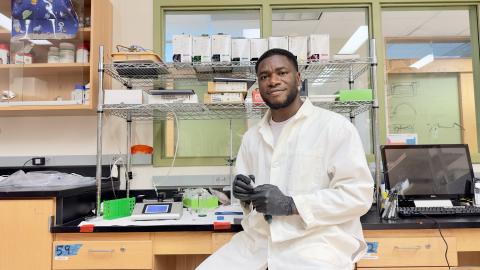With a new Scialog grant, Amanda Stockton is studying what roles sea spray aerosols might play, digging into how they may have impacted the evolution of life on Earth, and how they may help us search for life beyond Earth.
Along coastal shorelines, tiny drops of sea spray are flung everywhere – sometimes reaching the atmosphere, where they’re transported around the world. And within these sea spray aerosols are particles, chemicals, and even microbes.
“Sea spray aerosols are very important here on Earth,” explains Amanda Stockton, an associate professor in the School of Chemistry and Biochemistry. “Earth has a complex biology contributing to and living in the oceans.”
Now, with support from a $50,0000 Scialog grant, Stockton is studying what other roles these aerosols might play, digging into how they may have impacted the evolution of life on Earth, and how they may help us search for life beyond Earth.
Scialog: Signatures of Life in the Universe is an initiative launched in 2021 by the Research Corporation for Science Advancement (RCSA) foundation to catalyze fundamental science in the search for life beyond Earth. Scialog, which stands for “Science + Dialogue,” funds innovative, cutting-edge research, while supporting dialogue and community-building across fields.
For this project, Stockton will partner with Tyler Robinson, a professor at the University of Arizona who specializes in exoplanet observation and modeling. “Tyler and I met at the Scialog Conference, which aims to generate new ideas between cross cutting disciplines that are very unrelated,” Stockton says. “So what we were thinking here is Tyler's really good at exoplanet observation and modeling. My group's really good at microfluidic generation. At first, it seems like we don’t have anything to work on together. But it turns out we do.”
Additionally, Augustine Atta Debrah, a second-year Chemistry Ph.D. student in Stockton’s Lab, is playing a key role — Debrah’s research interests are rooted in analytical chemistry, and encompass analytical method development, mass spectrometry-based applications, microfluidics, chromatography-based applications, biosensors, and lab-on-chip devices..
“We are excited to explore the fascinating world of sea sprays through our research,” Debrah says. “By recreating and analyzing the behavior of these aerosols under controlled laboratory conditions, we aim to learn more about how they might have played a role in the early Earth's chemistry and what they could tell us about other planets.”
The team has no shortage of questions to answer together. “How might these aerosols impact what we would observe here from Earth with a telescope?” Stockton asks. “How might aerosols on other planetary bodies impact our search for life? And how did sea spray aerosols contribute to the emergence of life here on Earth?”
Tiny droplets, big impact
While sea spray aerosols have been previously studied, “We don't necessarily have a good handle on how sea spray aerosols might impact other planetary bodies, like a water world,” Stockton says, adding that “an exoplanet water world that doesn’t have continents and doesn't have the same sort of chemistry that Earth has” might have a different spectrographic ‘signature’ through a telescope.
To better understand this, Stockton’s group will generate microfluidic droplets with different chemistries, which they will cycle through different conditions, including different UV irradiation conditions and different temperatures, to model the various ways that aerosols could be transported through atmospheres.
“Then we could look at how the chemistry changes based on that transport phenomenon and also how the UV spectra or visible spectra changes,” Stockton adds. Scientists observe spectra – the light coming from each planetary object – as a way of better understanding what is present. Different properties can emit different spectra. “Eventually, we’d like to be able to see these from a distance and start to figure out what type of spectra you’d see for different conditions. For example, if the ocean has very simple organics, what you might find from just meteorites accreting to make the planet, versus the sort of spectra you might see if complex organic chemistry is taking place.”
The team also aims to uncover chemistries pertaining to early Earth by mimicking spectra from ocean chemistries that might have been present on early Earth, which could help researchers better understand how life emerged on our planet.
“There's a lot of things that also result from sea sprays on Earth that aren't necessarily being studied to the fullest extent,” Stockton adds. “For example, what are the stressors on these microorganisms and how does being confined in a droplet contribute to what pathways get turned on or off in the microbe, especially when that droplet may be evaporating, sublimating, or freezing?”
Early life on Earth — and life beyond
While Stockton notes that this research is still just beginning, there’s excitement in its focus – this year’s research will start to determine what is possible, and potential applications for the new model. “This is a proof of concept year where we want to see what we can build, what we can learn from what we can build, what the applications are of the system,” Stockton adds. “We hope that this will feed into bigger types of projects where we want to catalog what happens in multiple different types of conditions.”
The research has the potential to touch on some of the most fundamental questions humanity faces: who we are, how we got here — and many researchers, including Georgia Tech astrobiologists, are seeking to better understand water worlds like Encledeus, Titan, and early Europa.
“This project shows our dedication to uncovering the mysteries of the origins of life and expanding our knowledge about planets far beyond our own,” Debrah says.
“There are entire fields that we can branch into at varying levels of complexity,” Stockton adds. “We're very interested in what we can apply this to once we can build the hardware and show that we can do some of this controllably.”
Additional Images

